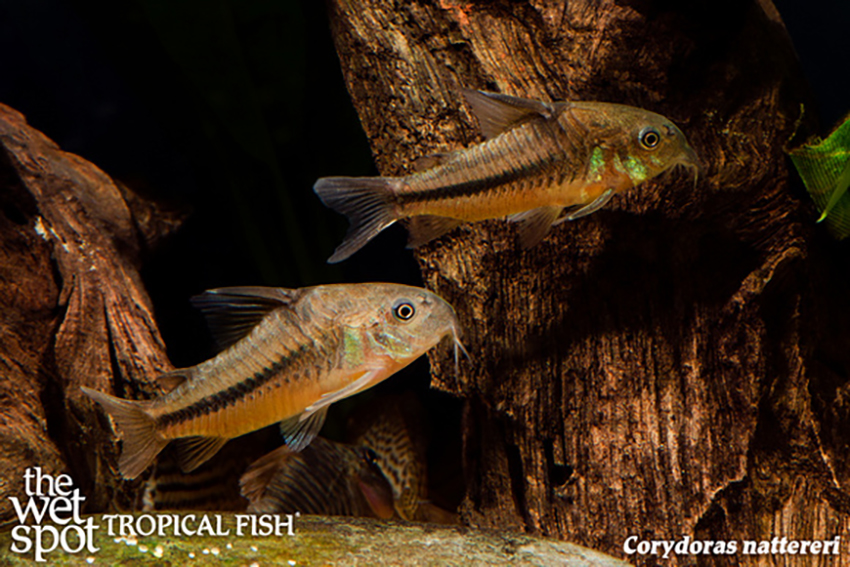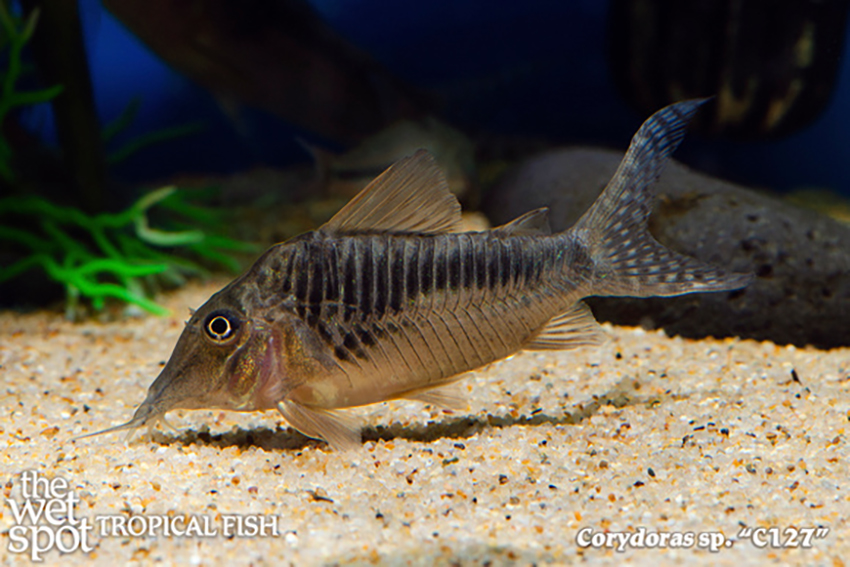A Cory Story
A good aquascape is built from the bottom up, and sometimes, the bottom is simply where it’s at, the best scapes staying shallow, focusing on arranging rockwork, driftwood, caves, mosses, and short, hardy plants. The most appreciative fish for these environments? Boisterous bottom-dwellers that spend their time exploring and navigating terrain: Corydoras! Often popular community tank inhabitants, “Corys” are active, diurnal, schooling, and gentle armoured catfish appropriate for most tank setups. With over 180 described species in the genus they are incredibly varied in coloration, pattern, size, and hardiness. There is certainly more than one species of Cory to love for every tropical aquarist…so, how do you choose? Luckily you don’t have to! The solution: long, shallow, intricate Cory tanks with several shoals. A few of our most “gotta have” Corys: Corydoras nattereri, Corydoras haraldschultzi, and Corydoras sp. “C127”.
Found in shallow tributaries, creeks, and flooded forests in Southern Brazil, C. nattereri are perfect candidates for Amazonian aquascapes. Reaching about 2.5 inches in length, they exhibit elegant, silver bodies, greenish golden metallic faces, and a dark horizontal stripe down their sides. As with all Corydoras catfish, they have bony plates along their flanks, pointed pectoral and dorsal fins, and adorable whiskers. Ideal biotope setup for these “Blue Corys” would include river sand, driftwood branches, piled rockwork, and dried leaf litter. As active bottom dwellers that are known to dig through substrate for tasty morsels, delicate plants are liable to become uprooted. Any plants should be hardy, and affixed to substrate. Rhizome plants like Anubias, Java Fern, or Bolbitis would be ideal. Mosses and floating plants would also be safe. Sometimes mistaken for scavenging cleanup crews, they do consume fallen morsels, but they aren’t good at cleaning substrate. Diets should consist of high-quality sinking pellets, and regular live and frozen treats. Generally suited to be kept alongside any other peaceful swimmer that can tolerate the same water conditions, they should be maintained in shoals of at least 5, and do best in lively setups. Tank waters should be kept with temperatures between 68 to 73°F, a pH between 6.0 and 7.5, and a hardness under 267 ppm.

Scientific Name:
Corydoras nattereri
Common Name:
Blue Cory
Temperature:
68° – 73° / 6.0 to 7.5 pH
Native Location:
Shallow tributaries, creeks, and flooded forests in Southern Brazil
Preferred Diet:
Omnivore
A truly exquisite Cory, C. haraldschultzi is found traversing the bottoms of the upper Rio Madeira in Bolivia and Brazil. Known more commonly as “Mosaic Corys”, they reach just over 3 inches and have intricate black squiggle patterns and spots over pinkish bodies. Typical Corydoras in many ways, they don’t have strict environment considerations besides that the substrate is soft and sandy to sift through without damaging their barbels, which should be kept scrupulously clean. They otherwise, appreciate well-placed furnishings like driftwood, rocks, and caves, and require airspace at the top of the tank. Peaceful tankmates, they are suitable for most community aquaria and are most happy in large groups of their own kind. When kept alongside other Corydoras species, they will keep to their own shoal, but cohabitate peacefully if enough bottom space and food is provided. Scavenging omnivores, they should be fed balanced diets including sinking pellets, live and frozen invertebrates, and at least some vegetal content. Tank waters should be maintained with temperatures between 75 and 82°F, a pH of 5.5 to 7.5, and a hardness under 179 ppm.
Scientific Name:
Trigonostigma espei
Common Name:
Pork Chop Rasbora
Temperature:
74° – 82° / 5.5 to 7.0 pH
Native Location:
The slow-moving sections of forest streams in Thailand and Cambodia
Preferred Diet:
Omnivore

Found in shallow tributaries, creeks, and flooded forests in Southern Brazil, C. nattereri are perfect candidates for Amazonian aquascapes. Reaching about 2.5 inches in length, they exhibit elegant, silver bodies, greenish golden metallic faces, and a dark horizontal stripe down their sides. As with all Corydoras catfish, they have bony plates along their flanks, pointed pectoral and dorsal fins, and adorable whiskers. Ideal biotope setup for these “Blue Corys” would include river sand, driftwood branches, piled rockwork, and dried leaf litter. As active bottom dwellers that are known to dig through substrate for tasty morsels, delicate plants are liable to become uprooted. Any plants should be hardy, and affixed to substrate. Rhizome plants like Anubias, Java Fern, or Bolbitis would be ideal. Mosses and floating plants would also be safe. Sometimes mistaken for scavenging cleanup crews, they do consume fallen morsels, but they aren’t good at cleaning substrate. Diets should consist of high-quality sinking pellets, and regular live and frozen treats. Generally suited to be kept alongside any other peaceful swimmer that can tolerate the same water conditions, they should be maintained in shoals of at least 5, and do best in lively setups. Tank waters should be kept with temperatures between 68 to 73°F, a pH between 6.0 and 7.5, and a hardness under 267 ppm.

Scientific Name:
Corydoras sp. “C127”
Common Name:
Smoky Cory
Temperature:
72° – 80° / 6.0 to 7.5 pH
Native Location:
The Rio Ucayali of Peru
Preferred Diet:
Omnivore
